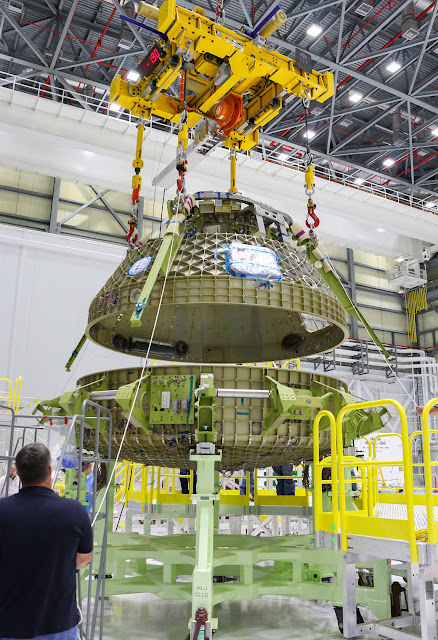 |
| Boeing's CST-100 Starliner under construction, October 2016. Photo Credit: Boeing. |
Now that the 2016 US Presidential election is behind us, it is possible to get an idea where the US space program is heading under President Donald J. Trump. Republican administrations traditionally have been friendly toward the space program - and, to be fair, Democratic administrations have, too, notably under John F. Kennedy and Lyndon Baines Johnson in the 1960s - and Republicans scored a rare sweep in the 2016 general elections. The government appears ready to give NASA some new missions, but exactly what they will be remains unclear.
 |
| Donald Trump at Orlando, 25 October 2016 (Photo: GREGG NEWTON). |
During an appearance at the Orlando Sanford International Airport on 25 October 2016, Donald Trump said:
My plan also includes major investments in space exploration, also right here [in Florida]. You know what we call this place.
Over the last 8 years, the Obama-Clinton administration has undermined our space program tremendously. That will change. So many good things come out of it, including great jobs. That will change very quickly under a Trump administration and it'll change before it’s too late.
Did you ever see what’s going on with space, with Russia and different places? And us? We’re, like, we’re like watching. Isn’t that nice? So much is learned from that, too.
A cornerstone of my policy is we will substantially expand public private partnerships to maximize the amount of investment and funding that is available for space exploration and development. This means launching and operating major space assets, right here, that employ thousands and spur innovation and fuel economic growth.
I will free NASA from the restriction of serving primarily as a logistics agency for low earth orbit activity. Big deal.
Instead we will refocus its mission on space exploration. Under a Trump administration, Florida and America will lead the way into the stars. With a victory in November, everything will change. Just think about what we can accomplish in 100 days.Obviously, these are very general remarks. So far, there are no specifics. Robert Walker, who chaired the House Science, Space, and Technology Committee in the 1990s, is helping to draft a plan for NASA. Walker is Executive Chairman of the Wexler|Walker lobbying firm and a former member of Congress from Pennsylvania. He also is a close crony of Trump ally Newt Gingrich.
Rumors are that the Walker plan will include:
- mining minerals from the asteroid belt;
- visiting Jupiter’s moon Europa;
- Restoring US independence from foreign sources for launches.
The US space program will continue to be intertwined with private space efforts, led by business moguls such as Tesla Motors chairman Elon Musk (SpaceX) and Amazon.com boss Jeff Bezos (Blue Origin’s New Shepard space vehicle). The Boeing Company of Houston has its CST-100 Starliner capsule ready to roll to supply the International Space Station (ISS). Aerojet Rocketdyne is providing the propulsion hardware for the Starliner.
 |
| Blue Origin software engineers before a Reddit “Ask Me Anything” chat session. (Credit: Blue Origin via Imgur). |
The Blue Origin project is the most exciting, but it also has issues outside the space realm. Trump and Bezos have had words about politics - not space - via Twitter. That might interfere with Bezos' NASA connection. However, the New Shephard appears to be a "next generation" type of project anyway, so it is unclear if it would even be ready to carry people during President Trump's (first) term in office. Certainly the company would say so, but that remains to be proven.
 |
| An artist's depiction of a Blue Origin capsule ejecting. |
It also is a bit unclear whether Blue Origin is focusing more on its own projects involving paying passengers, or working with NASA directly. While the company undoubtedly would say "both!" every company has to prioritize. Blue Origin appears to be a bit further away from being involved in the NASA supply scheme than the other two companies, though it has demonstrated the novel concept of re-usable rockets.
 |
| An artist's depiction of a Boeing Starliner docking with the ISS. Credit: Boeing. |
Boeing and SpaceX already have received crew mission orders due to reaching certain milestones. Boeing, in fact, already has two such orders because it is further along than SpaceX. Certification is required before flights occur, and both Boeing and SpaceX are set for 2-6 missions each under their current contracts. There is a 2-3 year lead time between Commercial Crew Transportation Capability (CCtCap) contracts and flights. Even if Blue Origin got everything in order quickly, it likely would not be launching before 2019-2020 because apparently it does not have any contracts in place. The first flights by either company would not be before late 2017 at the very earliest, and probably later due to normal scheduling delays.
NASA definitely is focusing on Boeing and SpaceX. NASA considers it important to have at least two separate launch systems available for redundancy. According to Kathy Lueders, manager of NASA’s Commercial Crew Program:
Once certified by NASA, the Boeing CST-100 Starliner and SpaceX Crew Dragon each will be capable of two crew launches to the station per year. Placing orders for those missions now really sets us up for a sustainable future aboard the International Space Station.U.S. Rep. Jim Bridenstine is rumored to be Trump's pick as Administrator of the National Aeronautics and Space Administration. Regardless of who heads NASA, under President Trump the agency is certain to spend less time and money on things like climate change and community outreach, while increasing military participation.
2016
